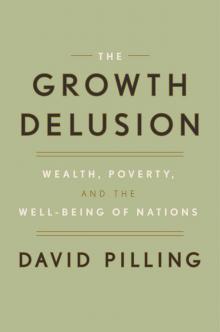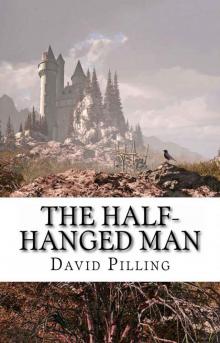- Home
- David Pilling
The Growth Delusion Page 10
The Growth Delusion Read online
Page 10
7
ELEPHANTS AND RHUBARB
One day in 2015 some economists working in Kenya had a bright idea. Literally. Knowing how hard it was to obtain accurate economic statistics in a country with limited resources, a large informal sector, and an economy that went from Mercedes-Benz-driving urbanites to cow-herding Maasai tribesmen, they looked for another way of measuring activity. The idea they hit upon was to use satellite imagery from outer space to record the intensity of lights at night.
Their method was less outlandish than it appeared. In poor countries from India to Eritrea there is a close correlation between the size of an economy as conventionally measured and light-intensity data from satellites. When plotted on a graph, downward blips in economic activity, say caused by drought, war, or a recession, are closely matched by a corresponding dip in light intensity. The idea rests on the assumption that almost all nighttime consumption requires some sort of lighting, making a rise in light intensity a good proxy for growth.1
Lights at night are as good at capturing informal as formal economic activity. That is a huge advantage in a place like Kenya. The farmers, hawkers, traders, nomads, artisans, repairmen, con men, day laborers, truckers, and metal bashers who help make most African economies tick generally work outside the taxed economy and largely beyond the purview of national statisticians. One of the basic tenets of our economies is that, if you can’t put a dollar sign against it, it doesn’t exist, but much of what makes Africa go round economically is invisible.
The night-light method has been used to gain a better understanding of the massive informal economy in India, a country of 1.3 billion people where more than 90 percent of the working population toils outside the formal sector. One could theoretically ask electricity companies how much power they sell in each district. But satellite imagery provides a more accurate picture, since official figures don’t count small off-grid schemes powered by solar or hydro. Nor do electricity companies properly account for the power that trickles away via inefficient grids or is stolen by poor communities adept at tapping power from overhead cables.
Light-intensity data has another advantage: it tells you more about economic activity at a local level than conventional data. Because of the high cost and practical constraints of conducting detailed surveys, poor countries rely on national extrapolations compiled from thin samples. The satellites that provide light-intensity data, by contrast, create a richer picture. Satellites circle the earth fourteen times a day, tracking data square kilometer by square kilometer. That is better than anything that could possibly be achieved by an employee of a national statistics bureau, clipboard in hand, going from village to village.
One surprising finding of the Kenya night-light study related to Nairobi, the capital, a city of at least 3 million people and a regional hub in east Africa. Light-intensity data indicated that Nairobi contributed about 13 percent to the national economy, a far smaller proportion than suggested by conventional national income statistics. If the night-light numbers are right, huge swaths of Kenya’s rural economy are being routinely undercounted.
The quality of economic data in many poor countries is shockingly bad. We put great store in them nonetheless. We use economic data to compare countries’ levels of poverty, to decide whether their policies are working, how much aid they receive, or what interest rates they must pay to borrow money. Yet a combination of methodological pitfalls and lack of institutional capacity renders many of the numbers on which we rely virtually meaningless. Different estimates of African GDP for the year 2000 compiled by the World Bank, the University of Pennsylvania, and the University of Groningen—three of the world’s most prestigious sources of national income data—reveal wild inconsistencies. One, for example, ranked the west African nation of Liberia as the second-poorest country on the continent. Another had it a full twenty places higher.2
One problem is that in most African countries the so-called black or gray economy—much of which by definition takes place in the shadows—is very large. So little is known about it that statistical offices resort to all sorts of ruses, proxies, and accounting tricks to fill in the blanks. Many countries simply do not have the resources. In Zambia in 2010 the national accounts for the whole country were compiled by a lone statistician. “What happens if I disappear?” the man asked plaintively.3
Zambia is a relatively stable country. What on earth are we to make of the statistics gathered in a place like the Democratic Republic of Congo, formerly Zaire, a Western-European-sized nation of 80 million people racked by years of civil war and with little that resembles a functioning state? Even if it had a working statistics office in the capital, Kinshasa, most regions of the country are inaccessible by road, with many places reachable only by riverboat or canoe. In Zimbabwe, where only 6 percent of the workforce is formally employed, one cabinet member, the nephew of veteran leader Robert Mugabe, told me over dinner that measuring Zimbabwe’s economy was “like trying to use a tape measure to figure out how much Coke is in this glass.”4
Even in countries not quite so challenged, the method recommended by the UN System of National Accounts to calculate and cross-check GDP—using expenditure, income, and production—is practically impossible. Only a few African countries, one of which incidentally is Kenya, even attempt it. Many use only production. “GDP statistics from African countries are best guesses of aggregate production,” says Morten Jerven, an expert on the subject. “Another way of phrasing this is that we do not know very much about income and growth in Africa.”5
That is quite a thing to say about a continent containing 1 billion of the world’s 7 billion people. We pretend our economic statistics and international comparisons have an accuracy that is simply not warranted by the facts. If even some of what happens in Africa is true of other developing countries in Asia and Latin America, then economies containing several billion of the world’s people may be producing highly dubious figures. All sorts of decisions, from aid to investment, are based on these numbers and all sorts of conclusions drawn about which policies work and which don’t, but we are mostly stumbling about in the dark. Kuznets thought his method was wholly unsuited to measuring poor economies where so much activity takes place in the informal sector. Yet that is precisely what we do. It is a pretty damning indictment of our capacity to paint a meaningful picture of the world.6
* * *
—
Terry Ryan is something of a celebrity. A local newspaper described the chairman of the Bureau of National Statistics as an “icon of Kenya’s economic scene.” Born and bred in the country, Ryan is baffled when outsiders look at his white skin and conclude he is not African. Brought up on a farm in Nakuru in the west of Kenya, where he worked briefly as a shamba boy—a field hand—he studied at two of the country’s best schools before completing his studies in Australia and Ireland and then in the US, where he rounded off his education with a PhD at the Massachusetts Institute of Technology. He lectured in economics at the University of Nairobi until 1983, when he was asked to join the Kenyan government as director of planning. Though retired from the civil service, he continues to play an influential role in the compilation of Kenya’s national statistics. The day I met him, in the spring of 2016, he was proofreading the latest set of GDP figures.
Ryan is a tall man with long, angular limbs, impeccable diction, and the slightly comic air of a character from a Dickens novel. When I went to see him on the top floor of the central bank, a dimly lit tower block in Nairobi’s old business district, he was clutching a battered brown leather suitcase, an accoutrement that, by all accounts, rarely leaves his side and is said to contain sheets of statistics dating back to the 1960s. At eighty-two, he was as sharp as a razor.
Ryan is proud of Kenyan statistics, which he says are among the best in Africa. Kenya has a competent civil service and a reasonably sophisticated economy, with cash crops, a cut-flower industry, light manufacturing, and a well-deve
loped tourism sector. It is also relatively prosperous by African standards, with income per capita of about $3,200 adjusted for local prices.7
Kenya follows the UN national accounts guidelines to the letter, though Ryan calls the income numbers it collects “very iffy.” Adherence to standard methodology notwithstanding, Ryan is at pains to point out that Kenya’s economic statistics are in no way comparable with those of, say, the US. “You are measuring elephants and rhubarb,” he says, conjuring up a metaphor that makes the comparison of apples and oranges seem mundane. So he has adapted the “rhubarb” methodology designed by Simon Kuznets to measure the US economy to the realities of an “elephant” economy like Kenya’s. “It’s perfectly correct for the developed world,” he says. “It makes admirable sense for the developed world. But it doesn’t necessarily transfer neatly into a developing-country context.”
Kenya is a country of roughly 45 million people. Some of its elite live like New Yorkers in expensive apartments or spacious houses in gated compounds, while others live in tin shacks or mud huts, or trek the vast open spaces as nomads. Nairobi is a modern city with skyscrapers, department stores, office blocks, motorways, prodigious slums, jazz clubs, restaurants, and one of Africa’s most advanced technology hubs. Even here, amid the traffic and the commerce, so-called urban shepherds trudge along with their herds of cows, which graze by the four-lane motorways or on the lawns of millionaires’ homes.8 Outside Nairobi, in the wilderness of Kenya’s beautiful landscape, is a whole other world. “We still have hunters and gatherers,” says Ryan. “Not many, but they’re there.”
Among Kenya’s patchwork of ethnicities are the Maasai, tall warrior cattle herders who once occupied the Great Rift Valley from modern-day central Kenya to northern Tanzania. The Maasai believe that all the world’s cows belong to them, a conviction that has brought them into inevitable conflict with other pastoralists and settled farmers. For them cattle are more or less everything. A greeting in the Maa language, from which the Maasai take their name, is “I hope your cows are well.” There are about 800,000 Maasai in Kenya, roughly the same number as the Turkana, a camel-herding people from the remote northwest.
The point is that much of Kenyan society lies outside the theoretical framework Kuznets was considering in America. That applies even to the many millions of sedentary subsistence farmers. In a good year they might produce a surplus, which they barter for other goods or sell at the local market. In a bad year almost everything they produce is eaten. Either way, most of their production never shows up officially.
Ryan takes the example of maize. He estimates that only half of all maize produced in the country is bought and sold. So the only way of counting the maize eaten by subsistence farmers is to impute its value. This is precisely the same concept used to impute the value of the rent that would be paid by owner-occupiers living in their own homes. “I know the number of households, and I know how much maize people actually eat,” Ryan says, since household surveys have established an approximation of the dietary habits of rural Kenyans. So he has a good idea roughly how much maize is grown and eaten by subsistence farmers.
In theory you could do the same with all manner of less obvious subsistence products. Benjamin Muchiri, a senior official at Kenya’s National Bureau of Statistics, says his office has tried theoretical exercises to work out the imputed value of non-marketed activities from the draft power of oxen working in the fields to the transport provided by camels. You could, say, compare the oxen to tractors and the camels to journeys by motorcycle taxi. One might even count the cow dung used to line the walls of huts as self-produced building material.
Including or excluding parts of the informal economy can make a big difference. In 2009 a study was made of milk, using data gathered in that year’s population census. This concluded that national income statistics for 2009 underestimated the economic contribution of milk by about twenty times. It also found that the total contribution of “ruminant livestock”—including cows, goats, and camels—was nearly $2 billion more than was captured in official statistics, no small discrepancy in an economy nominally worth only $37 billion.9 It estimated that 80 percent of beef consumed in Kenya was produced by pastoralists, including the Maasai, about a fifth of which was walked over the border from neighboring countries.
As well as providing meat and milk for their owners, livestock has other benefits not captured in normal economic exercises. Pastoralists, for example, use their cows as collateral that can be “cashed in” in emergencies. That saves the expense of taking out rural credit, which commands very high interest rates. Cows are walking bank accounts—literally cash cows. They have one further benefit. For protein, Maasai drink the blood of their cattle, which they siphon off sparingly from the jugular and mix with milk. The Maasai traditionally do not deign to plant crops, but live entirely off their livestock. Unless they kill a cow and sell it for money, they could spend an entire lifetime subsisting off their herd, practically invisible to GDP.
* * *
—
The difficulty of putting a dollar amount on such a rural economy might not matter so much if it wasn’t so big. Officially, agriculture accounts for 20 to 26 percent of Kenya’s economy, depending on the harvest. Even ignoring all the other problems of imputing the value of subsistence farming, this underestimates the sector’s economic impact. That is because money earned in rural Kenya is quickly spent on basics, thus moving around the economy with what economists call a high-velocity or multiplier effect. “I spend 100,000 shillings in the countryside, I get a lot for it,” Ryan says. “A high proportion of that will be generating more purchasing of toothpaste, more purchasing of dresses, hairdos. It really does circulate. It creates jobs, does all sorts of things.” In poorer countries, where the success of a harvest can be decisive and irrigation is almost nonexistent, weather experts, who can predict rainfall, make better economic forecasters than economists.
Miles Morland, who has been successfully investing in Africa for years, is also scathing about the quality of statistics. “You would think the fact that over 80 percent of the adult population in a country like Kenya, where NGOs solemnly tell us that ‘national income per head for half the population is less than a dollar a day,’ have mobile phones might lead someone with a functioning brain to question the statistics and ask how people with effectively no money can afford to buy so many mobile phones,” he snorts. He calls the hidden African economy Kioskenomics after the little kiosks where so many transactions are made beneath the radar of the taxman or statistician. “Anyone outside a Washington institution can see that income per capita in Africa must be vastly higher than the IMF figures indicate,” he says. This matters because these figures, which we take so seriously, “are the prism through which economists, politicians, bankers and planners the world over pass judgments on developing countries.”10
Ryan agrees that official statistics drastically underestimate the true size of Kenya’s economy. They suggest that 72 percent of the population lacks enough money to eat properly, he says. “So 72 percent of my people are dead. Sorry. Beaten again,” he says, throwing up his hands in mock resignation to the logic of standard economics. Yet clearly these Kenyans are managing to stay alive whatever the data tell us.
One explanation is that family and kinship structures mean wages earned by those in formal employment go farther. If averages are skewed in America and Europe because a few people have much more, in Africa it is generally the other way around. Of course there is gross inequality, but, typically, people with jobs support an extended family, from parents, uncles, sisters, brothers, and hangers-on to anyone who can claim even the most tenuous of connections. Ryan recalls an incident when someone walked into his office at the planning ministry complaining that Kenya’s GINI coefficient—which measures inequality—was “disastrous.” “I said, ‘Yes, it’s disastrous, but it doesn’t mean what you think it means,’ ” Ryan recalls. “It so happ
ened that the assistant minister in the planning ministry was an ex-student of mine. I knew him very well. So I said, ‘Wait, wait, wait. Let’s just go next door.’ So we walked into the assistant minister’s office, and I said, ‘Sorry for interrupting. How many people are you keeping on your salary?’ He thought for a while and he said, ‘Probably about fifty.’ I said, ‘Thank you.’ And we walked out.”
Ryan’s lesson is that you cannot take numbers at face value, even if they purport to be the definitive explanation of an economy. “You have to interrogate the data,” he says in a phrase that could come straight from Kuznets. “GDP tells you things that are worth knowing, but don’t think it tells you the answers to everything. See, what I’m trying to push,” he says, “is that this number is not a meaningless number. But you have to understand what its meaning is.”
* * *
—
Yemi Kale was finding it hard to sleep. He was harboring a dark secret. Numbers were swimming around in his head. He was sure they were right, but they were controversial. They could cause trouble. He thought of postponing their release and leaving the whole nasty business for his successor to deal with. “I was extremely uncomfortable,” he told me later.11 “I was tempted not to publish at all.”
Kale (pronounced Ka-leh) is a statistician. To be exact he is the statistician general of the National Bureau of Statistics of Nigeria, the most elevated number-cruncher in that huge west African country. You might consider a job in statistics, even one with such a grand title, to be one of the world’s dullest, right up there with accountancy or chicken sexing. That is not true in Africa, where working out the size of an economy is fraught with risks, even dangers. There were times when Kale feared for his safety. More than once he has received threatening calls from state governors, boiling with rage over what he had revealed about levels of poverty or unemployment in their fiefdoms. “This job is extremely controversial,” he says. “Our country is not very good at accepting the truth, whether it’s good, bad, or ugly.”

 The Growth Delusion
The Growth Delusion The Hooded Men
The Hooded Men Longsword
Longsword Medraut
Medraut Hardway
Hardway Holy Warrior
Holy Warrior Caesar's Sword: The Complete Campaigns
Caesar's Sword: The Complete Campaigns The Wolf Cub
The Wolf Cub Reiver
Reiver The Heretic
The Heretic Siege of Rome
Siege of Rome Loyalty
Loyalty The Path of Sorrow
The Path of Sorrow Caesar's Sword (I): The Red Death
Caesar's Sword (I): The Red Death Flame of the West
Flame of the West The Best Weapon
The Best Weapon Sacrifice
Sacrifice The Half-Hanged Man
The Half-Hanged Man